The United States insists it is a Pacific nation and has unveiled a raft of new strategies to better engage with other nations in the Region.
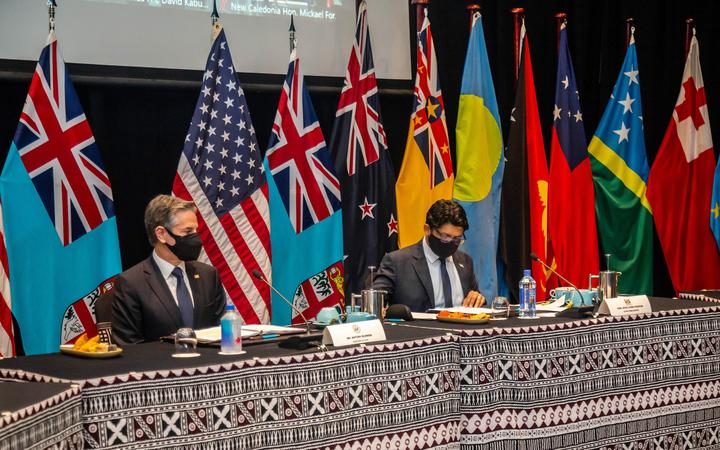 US Secretary of State Antony Blinken (L) attends a meeting with Fijian acting Prime Minister Aiyaz Sayed-Khaiyum (R) in Nadi, Fiji, on February 12, 2022. Photo: Leon LORD / AFP)
US Secretary of State Antony Blinken (L) attends a meeting with Fijian acting Prime Minister Aiyaz Sayed-Khaiyum (R) in Nadi, Fiji, on February 12, 2022. Photo: Leon LORD / AFP)
United States Secretary of State Antony Blinken is the first Secretary of State to visit Fiji in nearly 37 years.
During his historic visit, Blinken announced that the United States was pursuing deeper engagement plans with Pacific nations.
A key element and motivation for those plans is the strengthening of the US presence to match the growing influence of China in the Pacific.
In its engagement strategy, he said that China has combined its economic, diplomatic, military, and technological might to pursue “a sphere of influence in the Indo-Pacific and seeks to become the world’s most influential power.”
During an eight-hour visit to Fiji, while returning from a Quadrilateral Security Dialogue (QUAD) meeting in Australia, Blinken announced climate change financing, military and other exchange initiatives and plans for a new embassy in the Solomon Islands among other foreign diplomacy engagements.
Blinken has been on a world tour for the past several months to discuss two main issues: Covid-19 and China, with his counterparts including Australian Foreign Affairs Minister Marise Payne, Indian Minister of External Affairs Dr S. Jaishankar and Japanese Minister for Foreign Affairs Hayashi Yoshimasa.
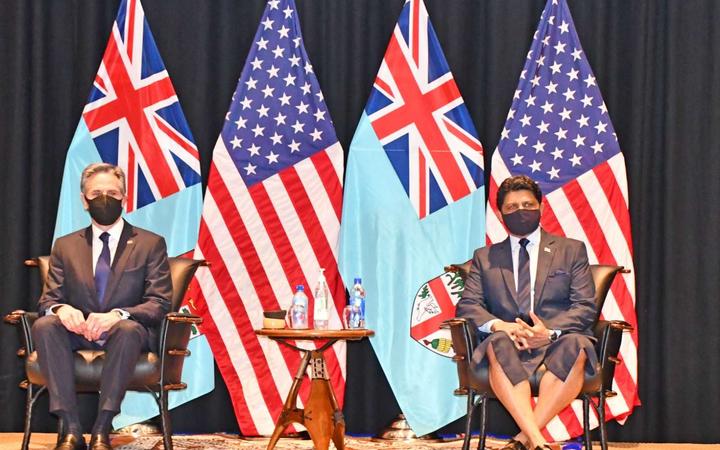 US Secretary of State Antony Blinken and Fiji’s acting prime minister Aiyaz Sayed-Khaiyum, Photo: Fiji Government
US Secretary of State Antony Blinken and Fiji’s acting prime minister Aiyaz Sayed-Khaiyum, Photo: Fiji Government
While in Fiji, Blinken met with acting Prime Minister Aiyaz Sayed- Khaiyum and 18 Pacific Island leaders, during which he announced the US government’s brand new Indo-Pacific engagement strategy, calling the region “vital to our own prosperity, our own progress”.
Blinken said that the new strategy was the result of a year of extensive engagement in the Asia Pacific region and would reflect US determination to strengthen its long-term position in the region.
“We will focus on every corner of the region, from Northeast Asia and Southeast Asia, to South Asia and Oceania, including the Pacific Islands. We do so at a time when many of our allies and partners, including in Europe, are increasingly turning their own attention to the region; and when there is broad, bipartisan agreement in the U.S. Congress that the United States must, too.”
This American refocus is a direct response to the increasing influence of China in the Pacific.
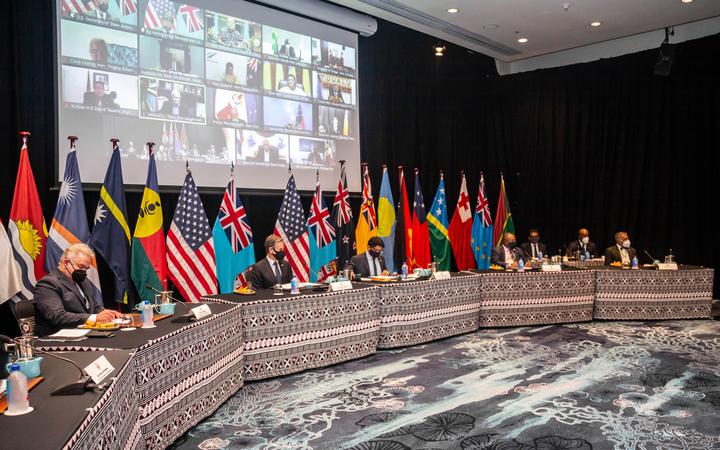 US Secretary of State Antony Blinken (centre L) attends a meeting with Fijian acting Prime Minister Aiyaz Sayed-Khaiyum (centre R) in Nadi, Fiji, on February 12, 2022. Photo: Leon LORD / AFP)
US Secretary of State Antony Blinken (centre L) attends a meeting with Fijian acting Prime Minister Aiyaz Sayed-Khaiyum (centre R) in Nadi, Fiji, on February 12, 2022. Photo: Leon LORD / AFP)
Since 2006, Chinese trade and foreign aid to the Pacific has significantly increased. Beijing is now the third largest donor to the region.
Although Chinese aid still represents only 8 percent of all foreign aid between 2011 and 2017 (according to The Lowy Institute) many Pacific island governments have favoured concessional loans from China, to finance large infrastructure developments.
In Solomon Islands, where Blinken announced the latest US Embassy would be opened, almost half of all two-way trade is with China.
In describing China’s actions toward expanding its influence, Blinken stated:
“The PRC’s coercion and aggression spans the globe, but it is most acute in the Indo-Pacific. From the economic coercion of Australia to the conflict along the Line of Actual Control with India to the growing pressure on Taiwan and bullying of neighbours in the East and South China Seas, our allies and partners in the region bear much of the cost of the PRC’s harmful behaviour. In the process, the PRC is also undermining human rights and international law, including freedom of navigation, as well as other principles that have brought stability and prosperity to the Indo-Pacific.”
When questioned by reporters about US intentions for “authentic engagement that speaks to the real needs of the islanders”, Blinken replied that the US sees the Pacific as the region for the future, and that their intentions were beyond mere security concerns.
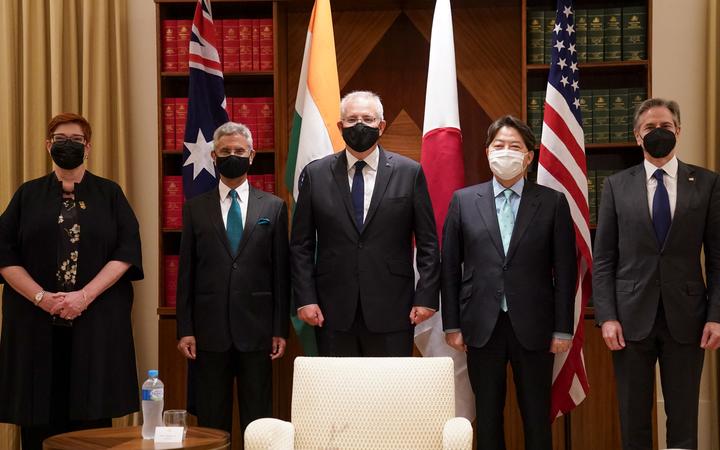 Photo: AFP
Photo: AFP
“It’s much more fundamental than that. When we are looking at this region that we share, we see it as the region for the future, vital to our own prosperity, our own progress. Sixty per cent of global GDP is here, 50 percent of the world’s population is here. For all the challenges that we have, at the moment we’re working on together, it’s also a source of tremendous opportunity.”
Blinken insisted that Washington’s new strategy was about using democracy and transparency to build a free and open Indo-Pacific who were committed to a “rules based order”.
Moving onto economics, the Secretary of State stated that the US intends to forge partnerships and alliances within the region, which will include more work with ASEAN, APEC and the Pacific Islands Forum. Despite being headquartered in Fiji, the Forum was not invited to be part of Blinken’s visit.
At the Pacific Leaders meeting, Blinken announced a commitment to deeper economic integration including measures to open market access for agricultural commodities from the islands.
“It’s about connecting our countries together, deepening and stitching together different partnerships and alliances. It’s about building shared prosperity, with new approaches to economic integration, some of which we talked about today with high standards.”
Washington’s new Indo Pacific engagement strategy also includes commitments to develop new approaches to trade, which meet high labour and environmental standards as well as to create more resilient and secure supply chains which are “diverse, open, and predictable.”
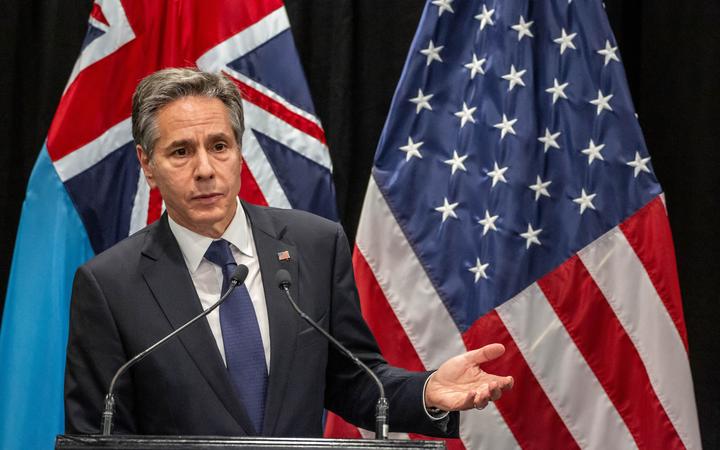 US Secretary of State Antony Blinken speaks at a press conference with Fijian acting Prime Minister Aiyaz Sayed-Khaiyum during his visit to Nadi, Fiji on February 12, 2022. Photo: Leon LORD / AFP)
US Secretary of State Antony Blinken speaks at a press conference with Fijian acting Prime Minister Aiyaz Sayed-Khaiyum during his visit to Nadi, Fiji on February 12, 2022. Photo: Leon LORD / AFP)
With regards to climate change, Blinken announced plans to divert substantial portions of the US$150bn announced at COP26 last year to the Pacific and also plans to make shared investments in decarbonization and clean energy.
The Indo Pacific strategy announced commitments to “working with allies and partners to develop 2030 and 2050 targets, strategies, plans, and policies consistent with limiting global temperature increase to 1.5 degrees Celsius”.
Blinken stated that the US is committed to reducing regional vulnerability to the impacts of climate change and environmental degradation.
On security matters, Blinken said the Pacific could expect power derived from US alliances in other parts of the world to come to the islands.
“The United States is increasingly speaking with one voice with our NATO allies and our G7 partners, when it comes to Indo Pacific matters, you can see the strength of that commitment to the Indo Pacific throughout the past year.”
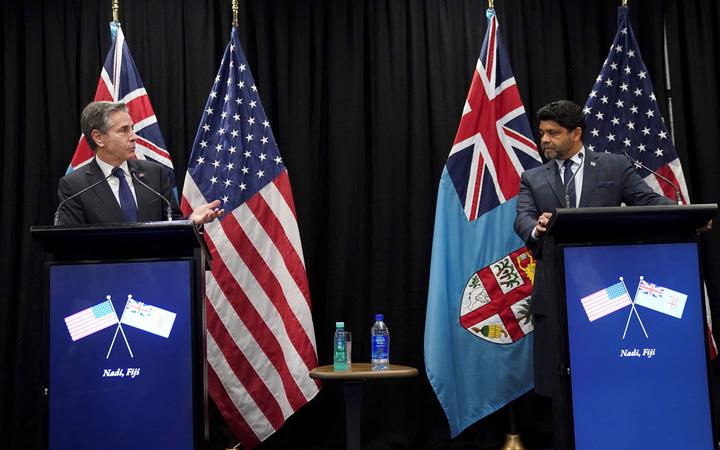 US Secretary of State Antony Blinken (L) takes part in a joint press availability with Fiji’s acting Prime Minister Aiyaz Sayed-Khaiyum in Nadi, Fiji on February 12, 2022. Photo: KEVIN LAMARQUE / POOL / AFP)
US Secretary of State Antony Blinken (L) takes part in a joint press availability with Fiji’s acting Prime Minister Aiyaz Sayed-Khaiyum in Nadi, Fiji on February 12, 2022. Photo: KEVIN LAMARQUE / POOL / AFP)
Leave A Comment